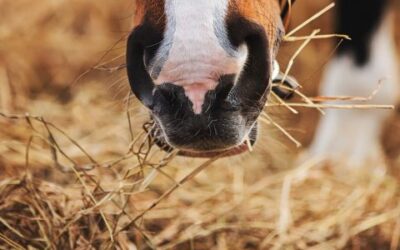Whether you are serving a bagged ration or your horse grazes in a paddock, the typical horse’s diet will consist of a assortment of grass varieties and clovers. Two of the most popular grasses for horses, timothy and alfalfa, make excellent components of a quality ration. If you are an owner purchasing a forage product, the first step is enhancing your hay I.Q. – start with this introduction of these two common hays.
Timothy
Feeding timothy blends? You can look forward to a shiny coat and healthy weight, among other benefits. Popular for its nutrition, digestibility, and palatability, timothy is part of a standard mix for horses, identifiable for its wide green blade and 1-3-inch seed heads for the first cutting and a softer, darker stalk with small or no heads for the second cutting. Its versatility means it can be excellent for the athlete, those seeking weight management, foundered horses (when soaked), and foaling mares.
Originally from Europe, today timothy grows all around the U.S. and Canada and popularly in Pennsylvania, New York, and in our own state of Maine. While known as a good source of protein, it can also be beneficial for horses that are sensitive to protein, as the percentage of protein varies widely, from 17% for early cut timothy – best for high energy needs – to 5% for late cut. Late cut timothy can be best for lower energy needs or for use with protein supplementation, and it provides higher levels of fiber.
Timothy is a first choice for a blend that nourishes and provides long chewing time for stabled horses. Its mixes can be quite cost effective, provided the consumer buys from a quality provider. For example, checking that early timothy cut has seed heads, a pale greenish tinge, and is not woody, can be a good indicator of quality. High quality blends, such as Lucerne Farms blends, combine first and second cuttings, mixing coarser stalks with tender stalks of the regrowth.
Alfalfa
Owners know that horses typically love alfalfa. A highly palatable hay, alfalfa is known as a high-quality feed that is popular when balanced with a blend. It is lower in digestible fiber than grass hay and supplies more calories per pound. Alfalfa supplies high protein, is a good source of calcium, and can be a dependable high-energy ration for mares, lactating mares, growing horses, and athletes.
Grown in every state in the U.S., quality alfalfa is leafy, bright green, and should be void of foreign materials. Blister beetles can be a concern when it comes to alfalfa; consumers should be aware of the dangers of this pest and purchase from trusted producers that take precautions to prevent it. (Or, consider producers in Maine, where blister beetles don’t live.)
Alfalfa has had its detractors for those wary of its health concerns, and it’s true that it has some characteristics that can exacerbate some conditions. Some of these concerns include a tendency to induce heaves, its high calcium/phosphorous ratio, and a tendency to make horses hyperactive, or “hot.” But experts stress that these concerns, while based in fact, have largely served to malign this hay. TheHorse.com provides a comprehensive list of myths associated with alfalfa so owners can embrace its benefits without concern.
Alfalfa is a rich hay and can contain, depending on age of harvest, at least 15% and as much as 25% to 30% protein – an average horse requires much less. But with the horse’s needs in mind, alfalfa can be an excellent part of a nutritional-rich blend for many types of horses.
Seeking Quality Blends
Quality hay and clean water are the cornerstones for a horse’s diet. As a consumer, it is beneficial to know what your hay supplier does to maintain the consistent quality product owners can rely on. Blends like Lucerne Farms can be mixed with any high-performance grain or feed with excellent results. Timothy and alfalfa blends can provide a very good option for a performance horse with its slow-release energy, optimum for working muscles. Forage in the mix means a horse will spend more time chewing and producing saliva while eating, two extremely important functions of a horse’s digestive process.
Whatever blend you choose for your horse, it’s always important to introduce feed changes, even different hay cuts from the same paddock, gradually.




